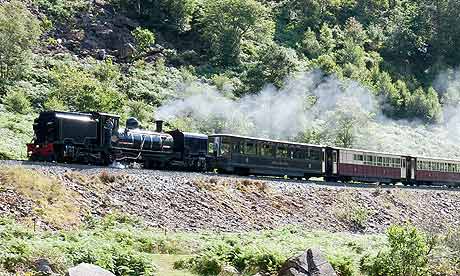
Journeys, new inventions, crime, the supernatural – these were the cutting-edge fictional topics for the Victorians as, in different manifestations, they are for us.
In the autumn of 1866, Charles Dickens had the shrewd idea of combining these themes in a group of collaborative "railway" stories, to be published in the Extra Christmas Number of his weekly magazine All the Year Round. The idea paid off, and an impressive 250,000 copies were sold.
The stories were issued as a complete collection, Mugby Junction, by the Hesperus Press in 2005. There are eight in total, four of which are by Dickens. The other contributors are far from amateurs, and would have been very well-known to readers of the time. They are Andrew Halliday, Charles Collins (Wilkie's painter-brother), Hesba Stretton and the novelist, travel writer and Egyptologist, Amelia Edwards.
I bought my copy of Mugby Junction last year on the way to King's Cross, aiming to mend the gaps in my Dickens reading. I recommend reading it on a long train journey, as I did. Though the rolling stock and landscape have changed, you can still look out of the window and see, from time to time, old engine sheds, rusting girders, sooty brickwork and freight cars, much like those that Dickens and the other authors describe. While the stories connect you to the past, it's a bonus to have traces of its physical reality within touching distance, reminding you not only how things have changed, but also how they haven't.
Mugby Junction itself is an imaginary Midlands station where seven lines intersect. As Robert MacFarlane says in the foreword, "it's an existential crossroads as well as a material one". The best fictional journeys usually generate, or accompany, a psychological voyage, and this is the premise of Dickens's two "Barbox" tales. The protagonist, Jackson, arrives at an unfamiliar station. It's not his destination, but, on impulse, he gets out of the train. He is a character almost effaced by sadness and failure, known at first merely by the company name printed on his luggage, "Barbox Brothers", or, to the puzzled railway-staff, "The Gentleman for Nowhere". How he finds his Somewhere and restores his identity is Dickens's theme.
It is, of course, a dark and stormy night. "A place replete with shadowy shapes, this Mugby Junction in the black hours of the four-and-twenty," Dickens observes, in fine form as he always is when his subject is railway travel. The nocturnal scene is powerfully realised: "Mysterious goods trains, covered with palls and gliding on like vast weird funerals … the half miles of coal pursuing in a detective manner …" An encounter with a genial character called Lamps sets Jackson on his new and brighter course.
These linked "Jackson" stories, Barbox Brothers and Barbox Brothers and Co, are like chapters in a novel, and suggest that Dickens needed a bigger canvas for the development of his plot. His tale hits the buffers in a sentimental coincidence – which I won't reveal, because there's still a lot of pleasure to be had from the journey. But be prepared for a saintly invalid, and a cute dimpled child.
Jackson now fades out of the picture. The other narratives concern new characters, though their stories were, supposedly, gleaned by Jackson as he wandered round the Junction, a fascinated newcomer. Their titles (No 1 Branch Line, and so on) represent the different railway lines, but the stories go off in various directions. It's a slightly rickety framing device, evidence of the combined pressures of running a weekly magazine and organising a literary collaboration.
Of the remaining Dickens pieces, one is the very fine ghost story, No 1 Branch Line: The Signalman and the other a satirical gem, Main Line: The Boy at Mugby. This latter takes the form of an anecdote by a disingenuous rogue of a refreshment room assistant, relating how the martinet in charge (Our Missis) sets forth to check out passenger catering on the Continent. She comes back with horrified reports of fresh picnic-baskets, a wide selection of drinks, good service and lively conversation – all the foreign nonsense outlawed at her own worthy establishment. Dickens loved France, and he clearly appreciated its station charcuterie. His wit sparkles like champagne, and you can almost taste the ham-filled "fresh, crisp, long, crusty" loaves, derided by Our Missis as "the universal French Refreshment sangwich".
Andrew Halliday's "No 2 Branch Line: The Engine Driver" is another lively monologue. The driver describes his job as if being interviewed. It's all very detailed, idiomatic and convincing: Halliday must have spoken to some real drivers, bringing with him his notebook and shorthand skills. It begins: "Altogether? Well. Altogether. Since 1841 I've killed seven men and boys. It ain't many, in all those years."
The women writers of the collection noticeably build the most ambitious plots. There's a clever, complicated spy story by Hesba Stretton. Amelia Edwards takes us from the Black Country to Genoa, with an astute account of two young men whose friendship and futures are ruined by their love of the same woman. The railways, it seems, inspired all these writers to branch out, whether geographically, psychologically, or in terms of narrative voice.
Steam transport must have been to the Victorians almost what the internet is to us – a revolutionary technology, loved, feared, fantasised. But in the end, of course, it's the human stories and voices which matter, and they're what make Mugby Junction so readable. If you find the usual Victorian novel too much of a long haul, this slim collection could be just the ticket.

